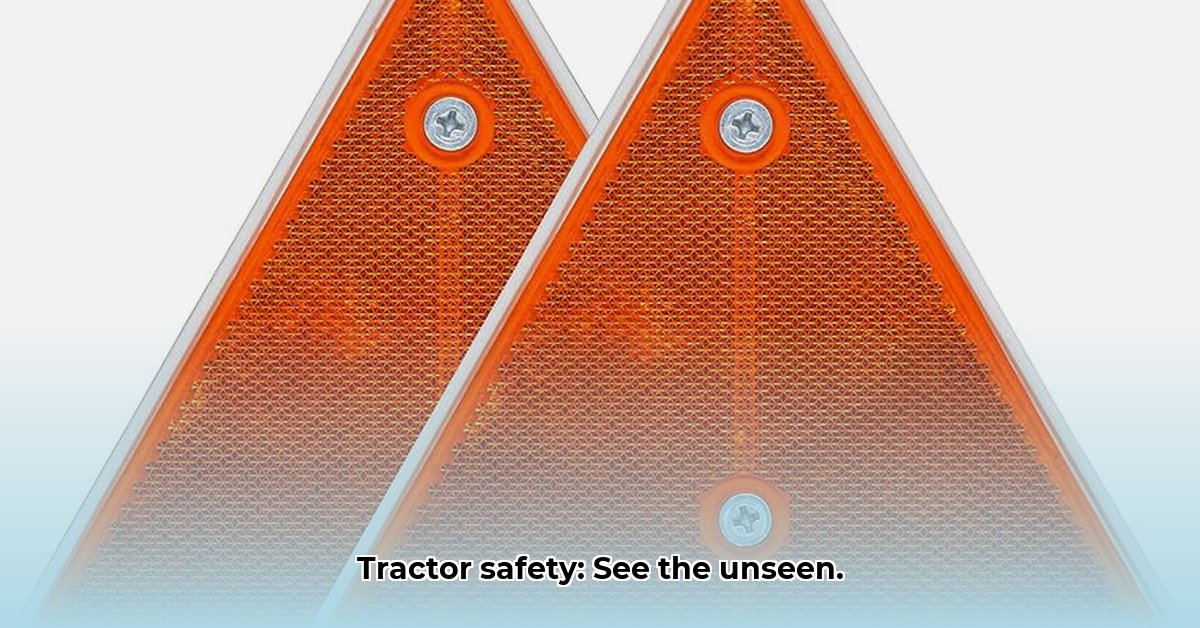
Safety Triangle for Tractor: Enhancing Visibility to Prevent Collisions
Farming is inherently risky, and tractor accidents, especially collisions with other vehicles, are a significant concern. A simple yet highly effective safety measure is ensuring optimal visibility of your tractor, primarily through the proper use of the Slow-Moving Vehicle (SMV) emblem—the ubiquitous red triangle. This guide provides a comprehensive understanding of SMV emblems, their proper selection, installation, maintenance, and complementary safety practices. For improved visibility, consider adding tractor mirrors.
Understanding Your Tractor's Safety Triangle (SMV Emblem)
The SMV emblem is a crucial safety device, universally recognized as a signal for slow-moving vehicles. Adherence to the ASAE S276.8 standard is paramount. This standard dictates the emblem's size, reflectivity, and placement for maximum visibility. A compliant emblem is easily visible even at night or from a considerable distance. Regularly inspect your current emblem for fading, damage, or improper placement.
[Insert image of compliant SMV emblem here] [Insert image of non-compliant SMV emblem here]
Choosing the Right Safety Triangle for Your Needs
Selecting the correct SMV emblem involves considering several key factors:
Material: Durable, high-reflectivity materials like aluminum or steel with engineered reflective sheeting are superior to cheaper plastic alternatives. These ensure long-lasting visibility under various conditions.
Size: Ensure the emblem meets the minimum size requirements specified in ASAE S276.8. Adequate size is crucial for visibility at a distance.
Mounting: Several mounting options exist, including adhesive backing and more robust mounting brackets. Choose a method appropriate for your tractor and operating conditions. Brackets are generally preferred for increased durability and resilience.
Installing and Maintaining Your Safety Triangle
Correct installation is vital for emblem effectiveness. Follow these steps:
Surface Preparation: Thoroughly clean the mounting area, removing dirt, grease, and debris to ensure optimal adhesion.
Accurate Placement: Center the emblem on the rear of your tractor, maintaining a height of 2-10 feet above the ground as per ASAE standards.
Secure Mounting: Follow the manufacturer's instructions carefully to ensure a secure and stable mount.
Regular Inspection: Periodically inspect the emblem for damage or fading. Replace it immediately if necessary.
Going Beyond the Basic Safety Triangle: Extra Protection
While the SMV emblem is essential, combining it with additional safety measures significantly enhances visibility and reduces accident risk:
Flashing Lights: These are particularly beneficial in low-light conditions and greatly improve visibility.
Reflective Tape: Strategically applying reflective tape to your tractor increases its visibility from multiple angles.
Driver Training: Regular training emphasizes safe driving practices, situational awareness, and understanding your tractor's limitations.
Staying Up-to-Date with Regulations and Future Trends
Familiarize yourself with your state or local regulations regarding SMV emblems, which may include requirements beyond the ASAE S276.8 standard. The field of farm equipment safety is constantly evolving; stay informed about advancements in warning systems and lighting technologies.
Emblem Selection: A Quick Summary
| Feature | Description | Importance |
|---|---|---|
| Material | Durable, high-reflectivity materials (aluminum, steel, etc.) | Ensures longevity and maximum visibility in all conditions. |
| Size | Meets or exceeds ASAE S276.8 minimum size requirements | Crucial for visibility at a distance. |
| Mounting | Secure and stable mounting (adhesive, brackets, etc.) | Maintains emblem position and effectiveness. |
| Regular Inspection | Inspect for damage and replace as needed | Ensures continued optimal visibility. |
In conclusion: Prioritizing tractor safety through the proper use of SMV emblems and complementary measures is not merely about compliance; it’s a critical step toward protecting lives and preventing accidents. Make safety your top priority.